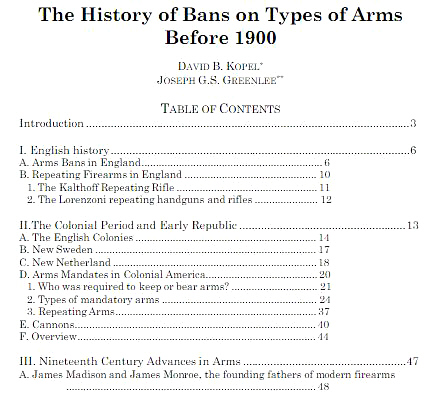

Review: The History of Bans
on Types of Arms Before 1900

By Dean Weingarten. Apr 25, 2023
Article Source
The History of Bans on Types of Arms Before 1900, by David Kopel and Joseph Greenlee, Law review article, 165 pages, 2021.
The Supreme Court in the seminal Bruen decision, held: once the clear text of the Second Amendment is implicated, the burden falls on the government to prove there were widespread and accepted statutory restraints in history which are very similar to the restraints the government is defending.
The law review article by Kopel and Greenlee is the most comprehensive compilation of the laws on ownership and regulation of arms from medieval England through 1900, especially on weapons bans, yet seen by this correspondent. Those laws are of varying relevance to interpretation of the Second Amendment. The article is astonishingly comprehensive. From the introduction of the article:
This Article describes the history of bans on particular types of arms in America, through 1899. It also describes arms bans in England until the time of American independence. Arms encompassed in this article include firearms, knives, swords, blunt weapons, and many others. While arms advanced considerably from medieval England through the nineteenth-century United States, bans on particular types of arms were rare.
In the early history section of the article, one startling fact revealed was the Royal Charter of King James I, in 1606, granted to members of the Virginia Charter, perpetual rights to:
bring "sufficient Shipping, and Furniture of Armour, Weapons, Ordinance, Powder, Victual, and other things necessary for the said Plantations and for their Use and Defence there."
The rights were granted to all settlers of the Virginia colony.
The Charter of New England colonies were granted the same rights. The two charters covered all of what would become the original 13 colonies except for the middle region which contained New York, Pennsylvania, Vermont and New Jersey. Those colonies were originally part of New Netherland, and were conquered by England in 1664.
Thus, most of the colonists in America had the right to arms before the right to arms was included in the English bill of rights, in 1689.
As part of the colonial history section, there is a well done glossary of terms used to describe various arms during colonial times.
Starting on page 37 the article presents a well researched history of repeating arms, including the Lorenzoni system and the Girondoni air rifle.
Starting on page 40, the article goes into wonderful detail about privately owned cannons. From the article, about an American who was hauled into a British court on a charge of planning to arm a Canadian revolt. The British Navy had seized 20,000 muskets and 24 field pieces from him in a shipment from France to America. Allen quote:
The freedom Americans always enjoyed to possess the arms of one's choosing was reflected in Ira Allen's defense when he was seized by British forces in 1796 while transporting 20,000 muskets and 24 "field pieces" (cannons and other artillery)from France to America. Allen said the arms were for Vermont's militia, whereas the British suspected he planning to arm a Canadian revolt against the British. He was prosecuted in Britain's Court of Admiralty. At trial, the idea of one individual possessing 20,000 arms was received with skepticism. Allen retorted that in America, "[a]rms and military stores are free merchandise, so that any who have property and choose to sport with it, may turn their gardens into parks of artillery, and their houses into arsenals, without danger to Government."241 The arms were restored to Allen. 242
On page 46, the article explains the obvious reasons for the creation of the Second Amendment in the American Bill of Rights.
Naturally, after facing the threat of disarmament and thus certain destruction, America's Founders were extremely protective of theright to arms. Before, during,and after the Revolution, no state banned any type of arm, ammunition, or accessory. Nor did the Continental Congress, the Articles of Confederation Congress, or the federal government created by the U.S. Constitution in 1787.247 Instead, the discussions about arms during the ratification of the Constitution and the Bill of Rights centered on ensuring that the people had enough firepower to resist a tyrannical government. There is no evidence that any of the Founders were concerned about individuals having too much firepower. After a long,grueling war against the world's strongest military, limiting individuals' capabilities was not a concern.
The article includes a very good history of firearms manufacture in the United States, and how it was encouraged and subsidized by the federal government. The article examines, in detail what firearm bans were enacted up to 1900. P. 67 summation of firearm bans in the 1800s:
In sum, the nineteenth century history of firearms bans is not helpful for justifying prohibitions on semiautomatic rifles. The only pre-1900 statutory precedent for such a law is Florida in 1893, and it is dubious. Before that, there were three prior sales prohibitions that covered many or most handguns. One of these was held to violate the Second Amendment, and the other two are plainly unconstitutional under Heller. Accordingly, renewed attention is being given to precedents involving Bowie knives, which we will examine next.
There are entire sections on the laws on Bowie knives, and on weapons which were not firearms or bladed weapons. The article notes throughout the historical period, military arms were more protected than non-military arms.
The article ends with a doctrinal analysis of the historical record as it applies to the Second Amendment through the Bruen decision.
This is an impressive, scholarly work. It will be referred to in cases involving the Second Amendment into the foreseeable future.
©2023 by Dean Weingarten: Permission to share is granted when this notice and link are included.
![]()

Click on image above for alternate access to PDF file
![]()

























